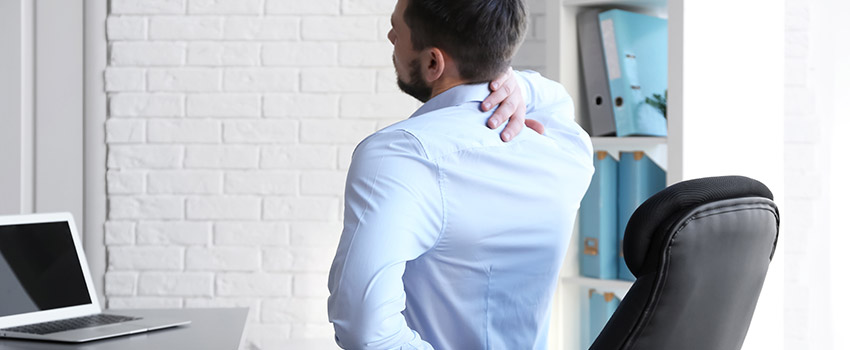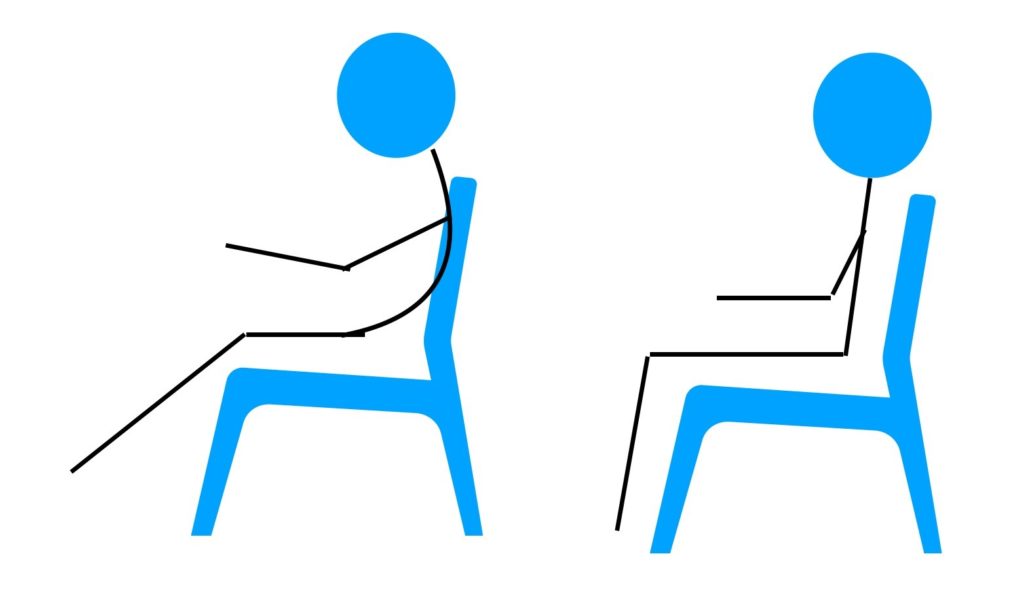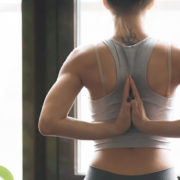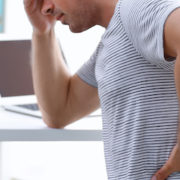Health Benefits of Good Posture
We’ve all heard it before, sitting up straight and correcting our posture is important. If only we could correct our posture, the world’s problems would be solved…. Maybe that is a slight stretch of the truth, but good posture does have wonderful health benefits. It has been shown to reduce back pain, neck pain, headaches, improve your mood, and make people take you more seriously. The list goes on, but let’s not get side-tracked this early on.
As you read the rest of this, get into your best posture possible. Starting from the ground up, keep your feet flat on the floor. Your knees should be at a 90 degree angle, and slightly lower than your hips. Rock forward on your sit bones to put a slight natural curve in your back. This is where people tend to over-do it, so let’s walk through this.
As you read the rest of this, get into your best posture possible. Starting from the ground up, keep your feet flat on the floor. Your knees should be at a 90 degree angle, and slightly lower than your hips. Rock forward on your sit bones to put a slight natural curve in your back. This is where people tend to over-do it, so let’s walk through this.

When first teaching posture I like people to go through the two extremes of their lower back, first sink into poor posture and notice how your low back rounds out. Now sit up really tall, and exaggerate the curve in your low back. Notice that as you do this you can feel pressure in your back, and it should feel uncomfortable. I tell people to find the common ground between the two extremes, and start with that as a good curve in your low back. Your abdominals should be working in a way to pull everything up and in, as if there is a zipper from your waist up to your rib cage. It also is nice to put a small lumbar pillow or support behind your back, this will help keep your lumbar curve and limit your slouching.
Bend your elbows to 90 degrees with palms towards the ceiling, slowly rotate your arms away from your body while keeping your elbows tucked into your side. Notice how the muscles around your shoulder blades are turned on, and working to maintain this position, now keep it while you let your arms rest at your side. While holding all of this in, imagine you are elongating your spine as if you were pulling the top of your head towards the ceiling. This should help engage your abdominals slightly, and orient your neck in a good position. Pretend like you are holding an apple under your chin, this requires a slight chin tuck to keep this position. If you followed these instructions, you should be in pretty good posture!
Correct vs. Incorrect Posture
Below is a very simple version of incorrect vs correct posture. Notice how the spine tends to take a majority of the stress. This can lead to a number of different problems within the body, which is why correcting your posture is so important!

So what causes poor posture? Gravity, muscle weakness, lazy, tight muscles, cellular phones, the seat you are sitting in, work, your boss, stress…… Another list that would be too exhausting to cover today. Ultimately, you are in charge of your own body, and it comes down to you as the person living in your body to correct your posture.
Are you still sitting in your good posture? If not, take a second to correct this and recognize that this is hard work! Holding good posture can be an exercise in itself, but it’s not the cure-all for what ails us. Spoiler alert, keep reading to find out more!!
As a child I remember making silly faces to annoy my mom, her response was always “if you keep that look on your face it will become permanent.” While this is not true with these silly faces, it is true with your posture. Your body works in amazing ways, and will adapt. So if you continue to slouch, and sit in poor posture it will slowly adjust over time. The muscles of our body will adaptively shorten, the joint capsules will slowly stretch, our muscles will weaken, that hump on your back will slowly enlarge. Take a second and check in with your posture, are you slouched? If so, imagine being stuck in this position forever. Scary huh? Sit up straight and keep reading.
Posture is important, because it lays the foundation for the rest of your body.
How to Fix Your Posture
Posture is important, because it lays the foundation for the rest of your body. When we have good posture, our body is in better alignment. The small postural muscles that support our head and neck can work more efficiently. Proper posture also helps to keep your spine in a neutral position, preventing excessive stress on our back. There is better alignment among the other joints of our body as well. Our shoulder joints will be more congruent, with less compensation from the incorrect muscles. The hip sockets will be in the optimal position with activity, creating less compensation from our low back. Another opportune time for me to ramble on, but that’s enough pros and cons with posture, what can we do about it?
- Stretch the muscles in the front of your body
- We live in a society that likes to flex forward, whether we are sitting, watching television, driving, etc we are always in a forward flexed posture. This will adaptively shorten our pecs (chest muscles), hip flexors, quadriceps, abdominals, etc. These are all muscles in the front part of our body, reinforcing our tendency to flex forward.
- Strengthen the muscles in the back of your body
- If everything in front is tight (refer to step 1) that makes everything in the back stretched out and weak. In order to correct this imbalance, we must strengthen these muscles to better stabilize ourselves. The glutes, hamstrings, spinal stabilizers, middle and lower trapezius muscles are all important to strengthen.
- Engage and strengthen your core
- This is a challenge for most people who do not know how to engage these muscles. There are four main muscles that constitute the core and include: the diaphragm, transverse abdominus, multifidus and the pelvic floor. Getting your body in tune with using these muscles will create better stabilization of your spine, and help encourage better posture.
- Proper ergonomics for work
- We spend a lot of time at work, sometimes too much time. Therefore, it is imperative to get organized and set up your workspace to accommodate you and your new found love of posture. While I can’t follow everyone to work, I can provide you with a link to OSHA’s website to coordinate these guidelines if you Click here.
Join us for a free posture demo at Bodywise Physical Therapy
These are a few basic things to get you started on your path to postural correction. As you finish reading this, take one last look and feel of your posture. How does it feel? It is okay to have struggled to hold correct posture the whole time, but should highlight some of the areas that you need to work on. This is just a starting point in addressing your posture, to improve upon what you have just read, join us for a free posture demo at Bodywise Physical Therapy. We will provide an in depth discussion on posture, while also providing hands on learning to help you correct what ails you. Check our Facebook page for updates on the time and location of the class.





